Peru, 2014 Trip Report
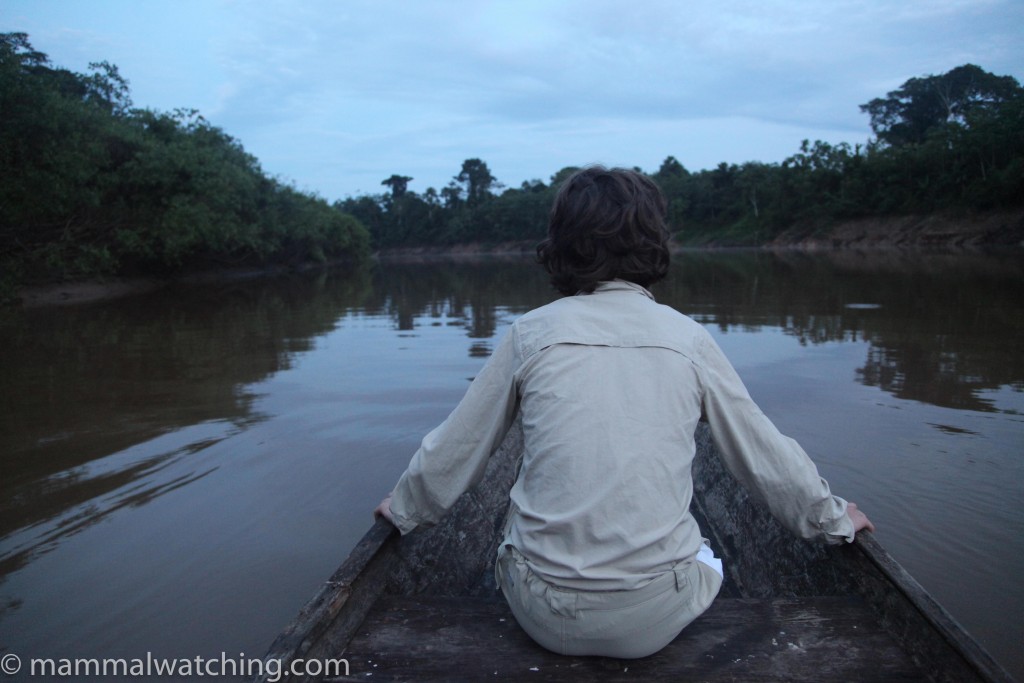
Patrick on the Tapiche River
In 2010 I promised my son, Patrick, a trip to the rainforest to mark his entry into teenhood. After some lengthy negotiations with his mother, followed by Patrick successfully completing 13 challenges, we flew to Peru on 12 July, 2014, about a year later than I’d hoped. It was the first visit to Peru for both of us and we had only a week.
I was keen to spend a night or two at Chaparri Lodge where I figured the bug-obsessed Patrick could find some cool stuff, and where I could see Sechuran Foxes, followed by a few days in the Amazon. My initial plan was to visit Manu to see Emperor Tamarins. That was until Jacob Socolar got in touch to recommend a new private reserve, Tapiche, upriver from Iquitos, which was home to Red Uakaris and a bunch of other good stuff. This proved to be a great decision.
Chappari Lodge, Lambayeque
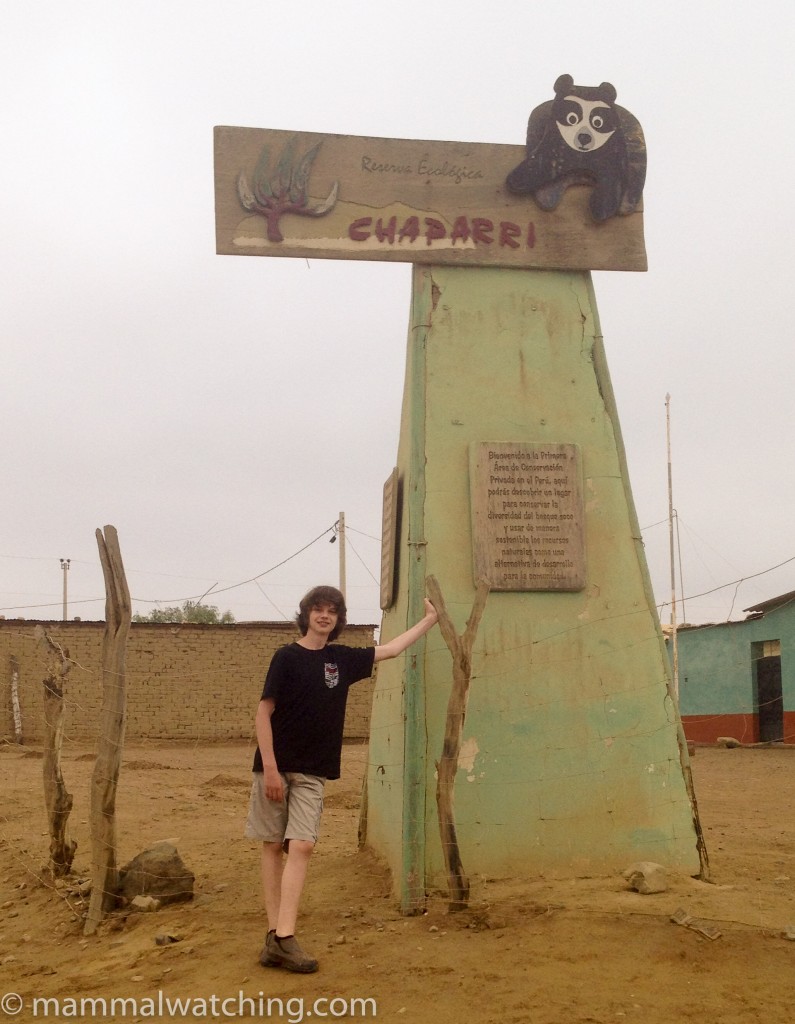
Chaparri entrance
Chappari Lodge is a 90 minute drive from Chiclayao Airport. We flew in early on a Saturday morning and Juan Andres, our guide, met us at the airport for our 48 hour visit. Juan’s family set up the lodge and the reserve that surrounds it: the reserve is run as a sort of cooperative of various local farmers who donated land and receive a share of the visitor entry fees and so on in return.

Chaparri desert
The lodge is in the desert of the Andean foothills and it’s quite beautiful country: bone dry, all skinny trees and cactus, with strands of gallery forest running along creeks, with the best forest we saw along the creek running by the lodge itself. In the background the Andes rise up to meet occasional Condors circling overhead.
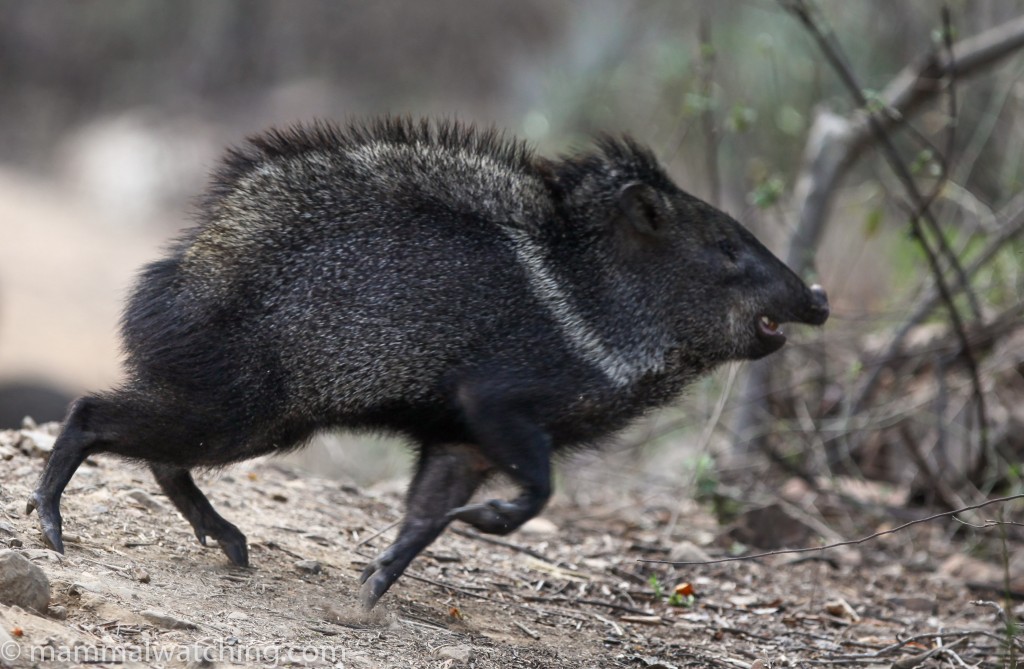
Collared Peccary, Pecari tajacu
Sechuran Fox was my main target and Patrick spotted one before we had even got out of the car.
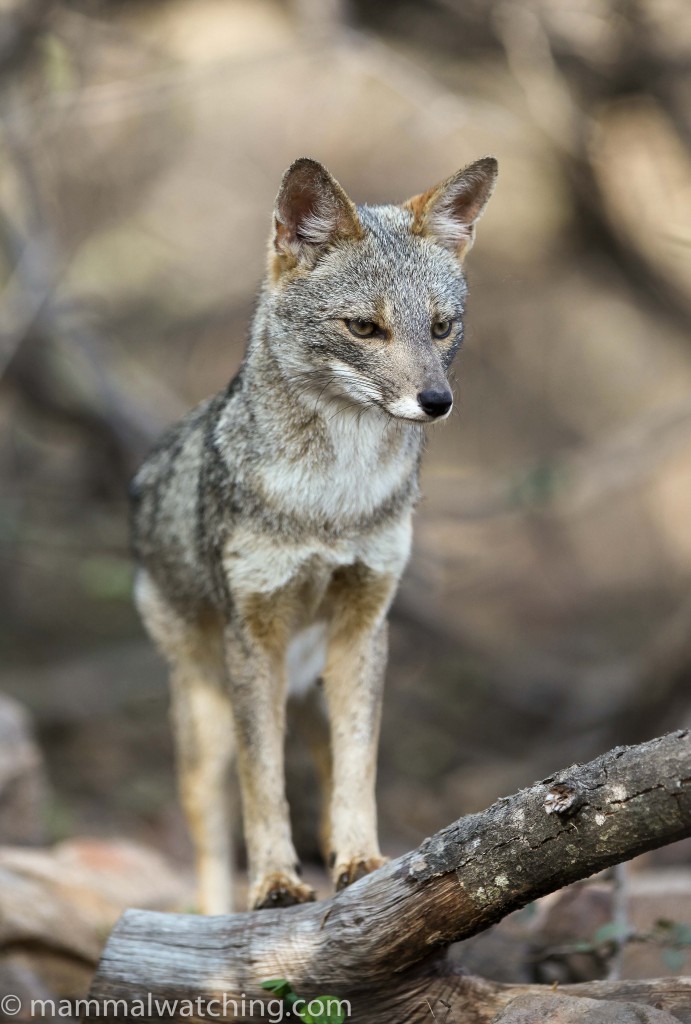
Sechuran Fox, Lycalopex sechurae
We saw many more over the next few days. They were perpetually around the lodge.
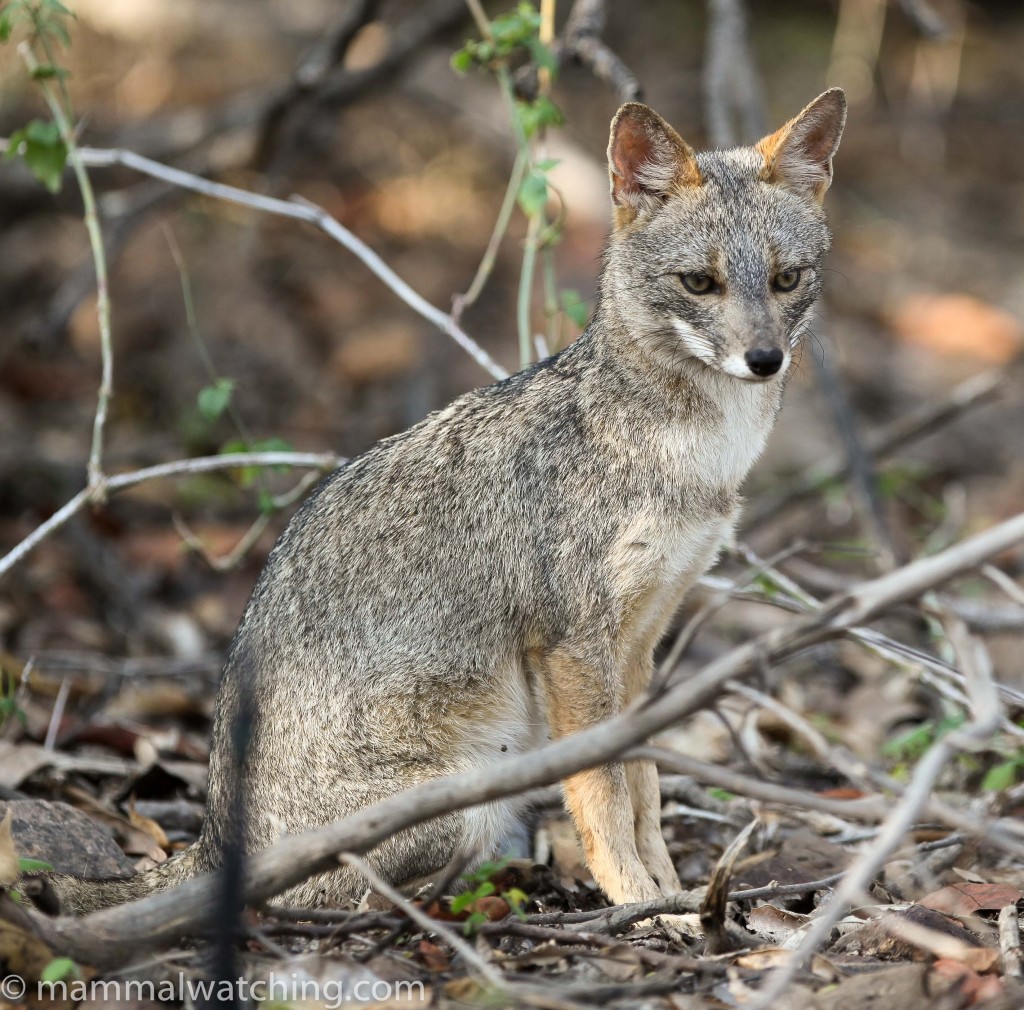
Sechuran Fox, Lycalopex sechurae
We spent the next 2 days walking the trails, mainly between the lodge and the Spectacled Bear enclosure as this, according to Juan, is where the mammal action mainly happens.
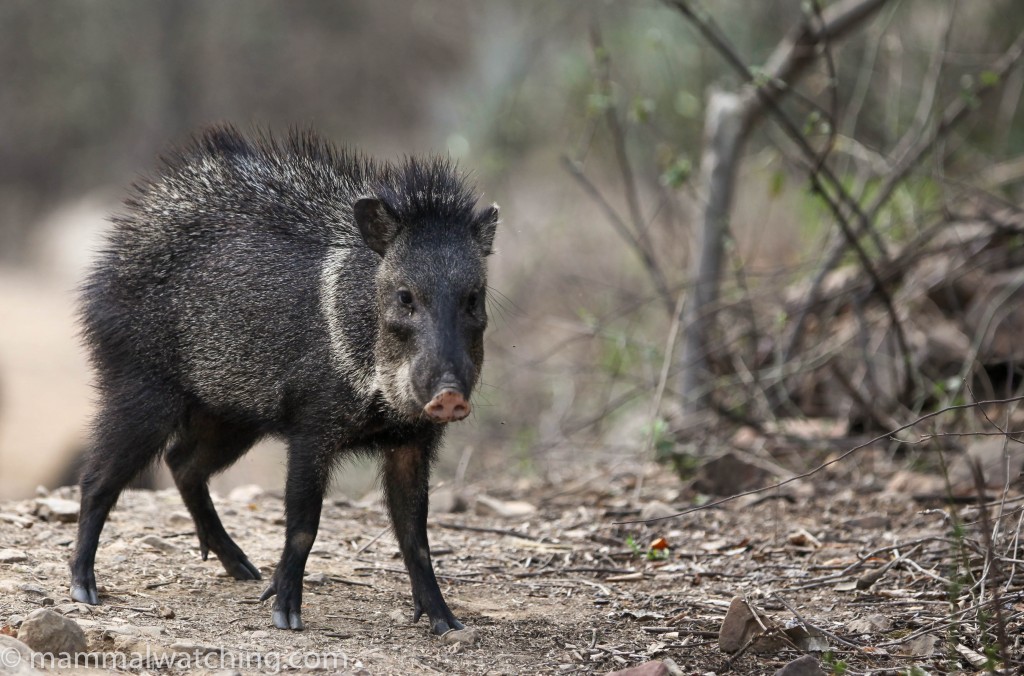
Collared Peccary, Pecari tajacu
Foxes were always around the lodge, as were habituated Collared Peccaries (some of which were rescue animals) and White-tailed Deer were usually along the trail to the bears.
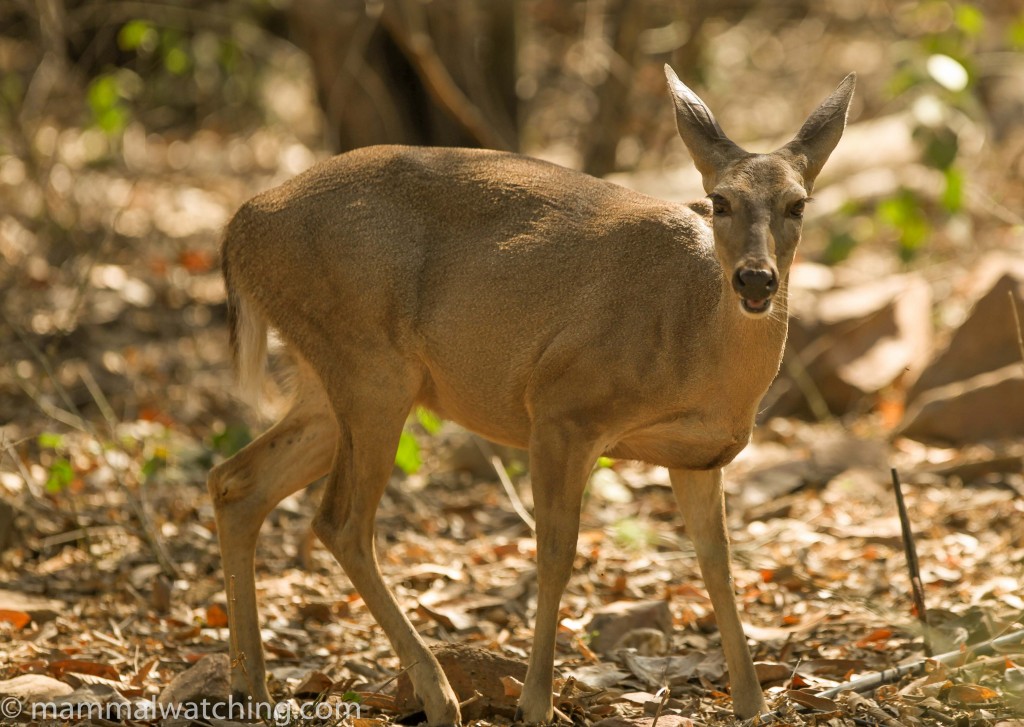
White-tailed Deer, Odocoileus virginianus
The lodge keeps seven Spectacled Bears (all rescue animals) in large enclosures about 10 minutes’ walk along the creek: great to observe, photograph and feed by hand.
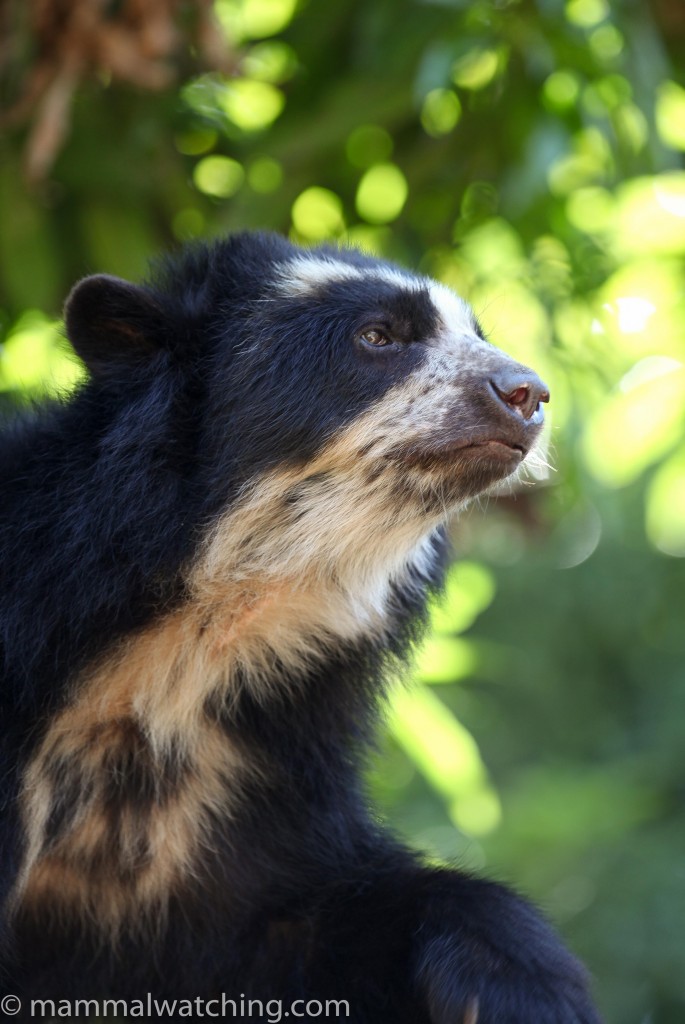
Captive Spectacled Bear, Tremarctos ornatus
Their presence also occasionally attract some of the park’s wild bears: Chappari is reputed to be one of the best places to see Spectacled Bears though I didn’t put much effort into looking for them. Near the bear enclosure a small pond is a good place to see Guayaquil Squirrels, my other target. We didn’t see any squirrels there despite numerous visits but Juan did spot a rat at 11 a.m. which Fiona Reid confirmed was a Cotton Rat – the Peruvian Cotton Rat – a recent split from Sigmodon hispidus and a lifer for me.
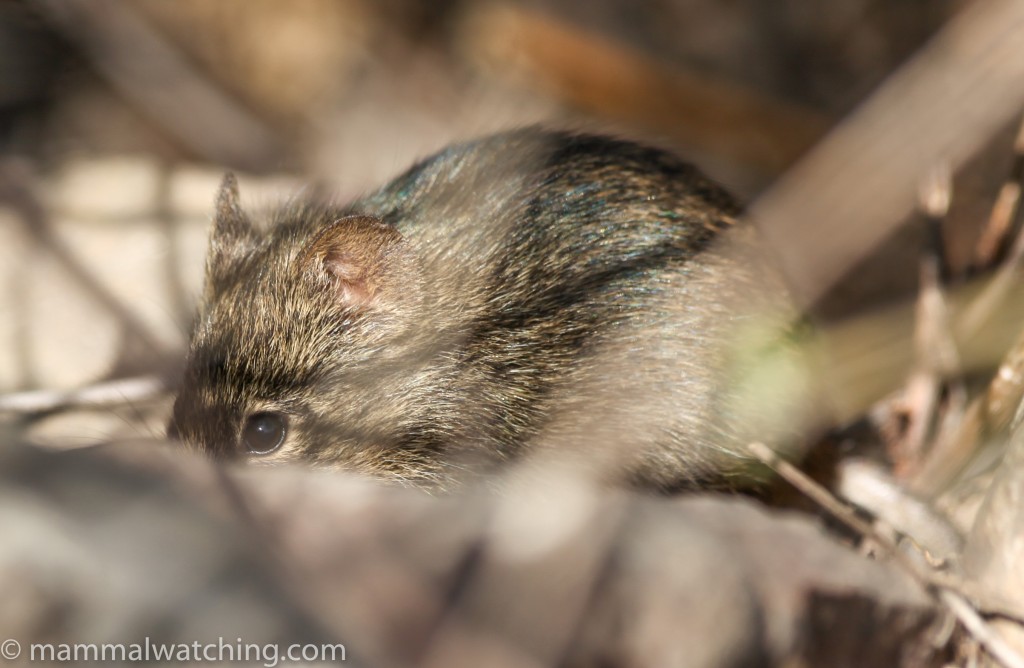
Peruvian Cotton Rat, Sigmodon peruanus
I spend most of the rest of the two days pacing the trail looking for Guayaquil Squirrels and whatever else might appear. Squirrels are apparently common around the lodge itself and along the trail. We couldn’t find one until the very end of our stay: literally as we returned to our room to pick up our bags on the last morning when Juan spotted one just opposite our front door. I had only a minute to grab a very bad picture before dashing for the airport.
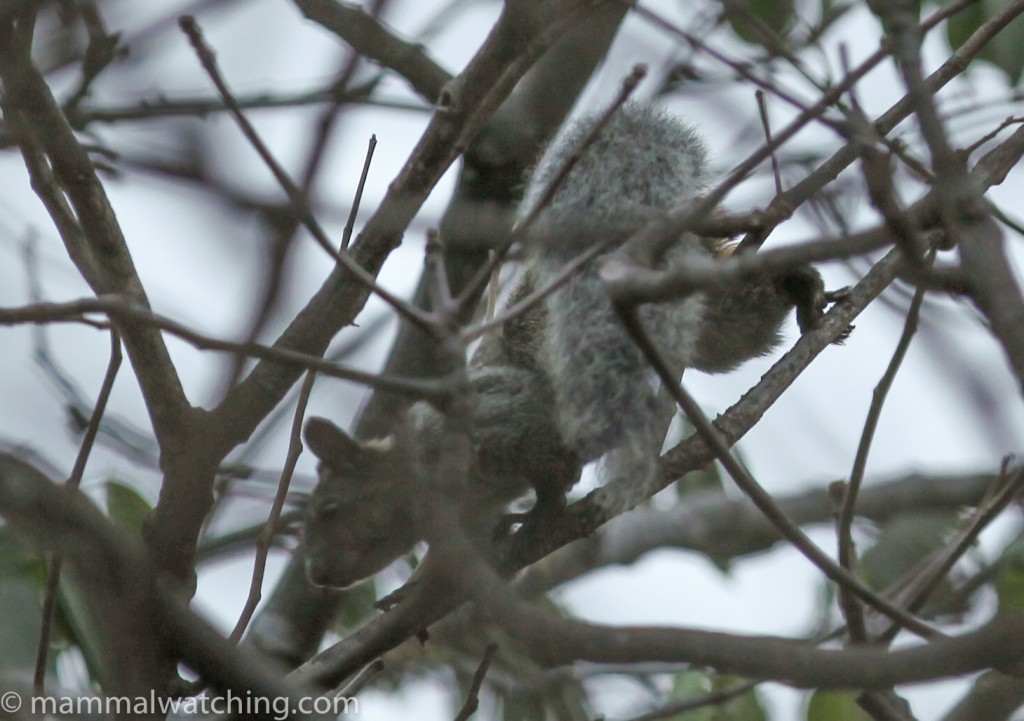
Possibly the world’s worst picture of a Guayaquil Squirrel, Sciurus stramineus
As I’d hoped – for Patrick’s sake – the place was alive at night with tarantulas and scorpions, which Juan tracked down using a UV lamp. The spiders were fun to feed. Patrick persuaded me to let them run over my fingers, after he did the same.
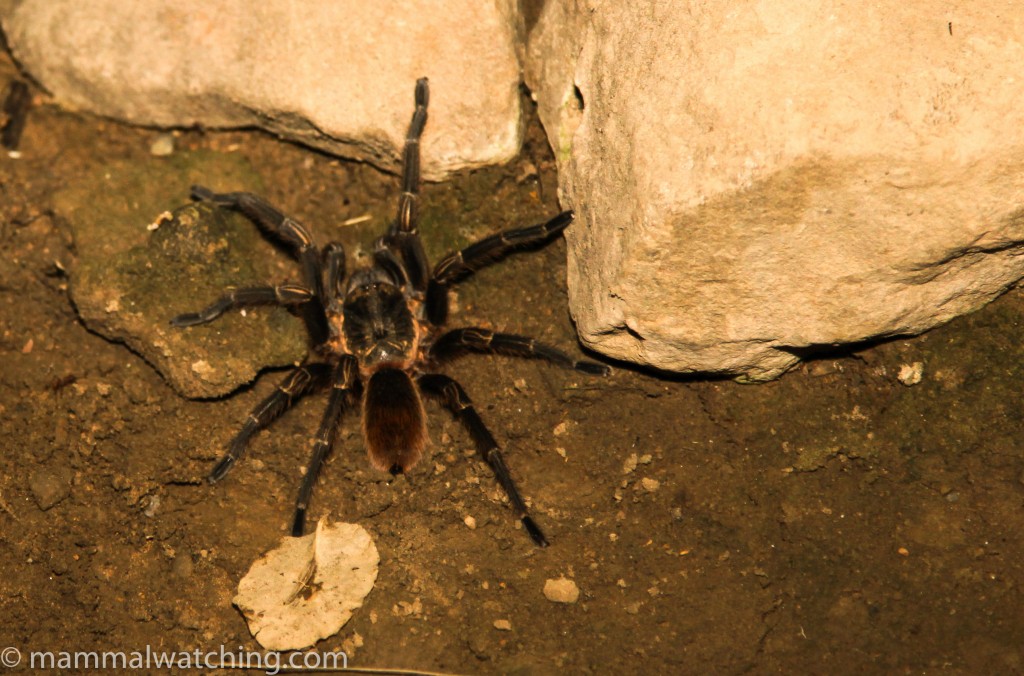
Tarantula
The best mammal I missed was Pampas Cat which seems not ro be uncommon around the lodge as they are often caught in camera traps. But they are extremely hard to see because of their secretive nature and love of dense cover. Pumas and Tayra are also seen from time to time as well as Hog-nosed Skunks. Higher up the mountain there is an undescribed species of Porcupine. I didn’t go to look for it as I guess we would have needed a vehicle – or a long walk – to reach the right area.
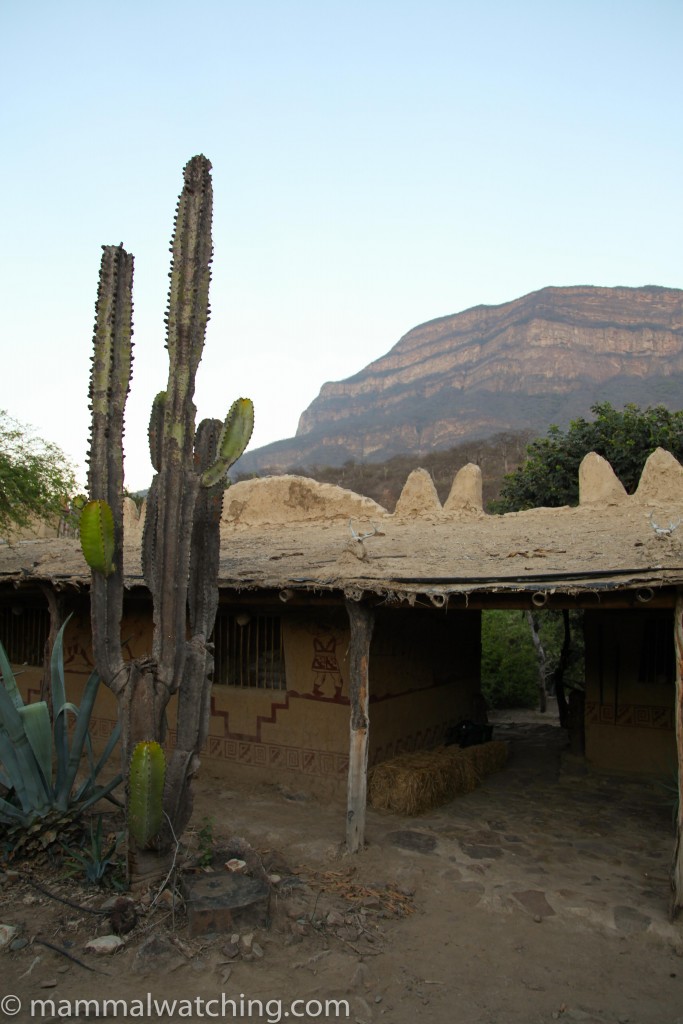
Chaparri Lodge
Many thanks to Juan Andres, the Sechuran Foxes and the chef at the lodge for a very enjoyable couple of days.
Tapiche Reserve, Loreto
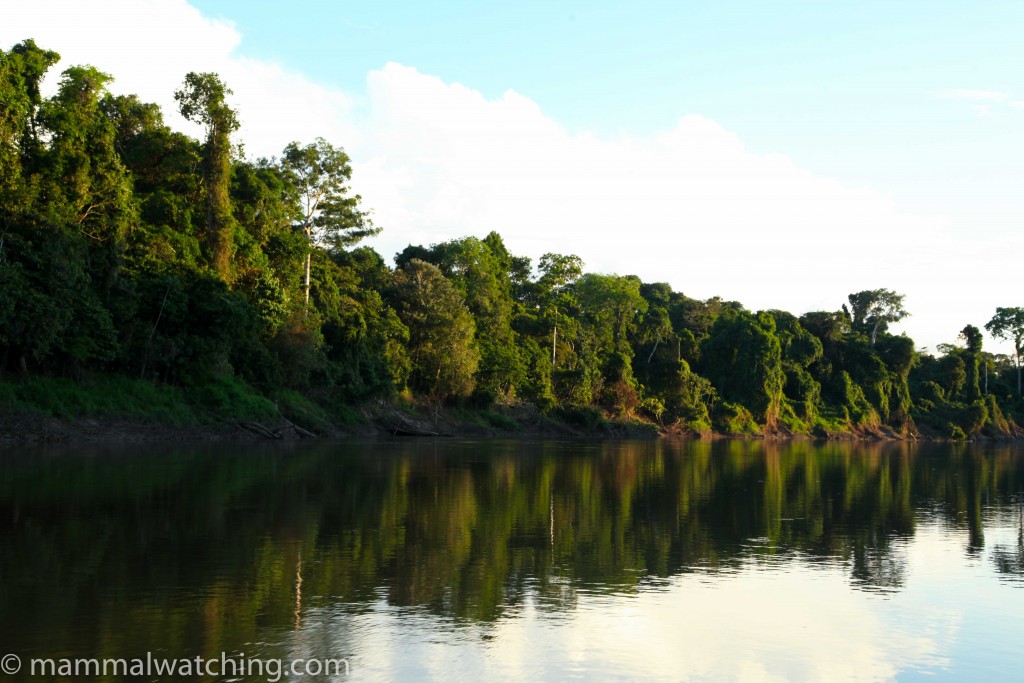
It took all day to fly from Chiclayo to Iquitos via Lima. This was my fourth trip to the Amazon: after visiting Rio Cristalino in Brazil, Yasuni National Park in Ecuador, and Palmari (in Brazil but usually reached via Leticia in Colombia) it was hard to think of a place that would give me a chance to see many new species, so I decided to focus on trying to see at least one species that I was particularly keen to see. In Peru, two candidates were Emperor Tamarins (which appear to be seeable only around Manu) or Peruvian Red Uakaris (seeable around Tapiche, where I was told there was a healthy population – thanks Jacob Socolar!).
I decide on Tapiche as it sounded like my kind of place: relatively remote, not very touristy, and Katoo, the guy running it, was passionate about making a real difference for conservation.
Iquitos, capital of the Peruvian Amazon, is one of the biggest cities in the world not connected to a road network: the final 30 minutes flight over the forest gave a sense of the enormity of the Amazon basin.
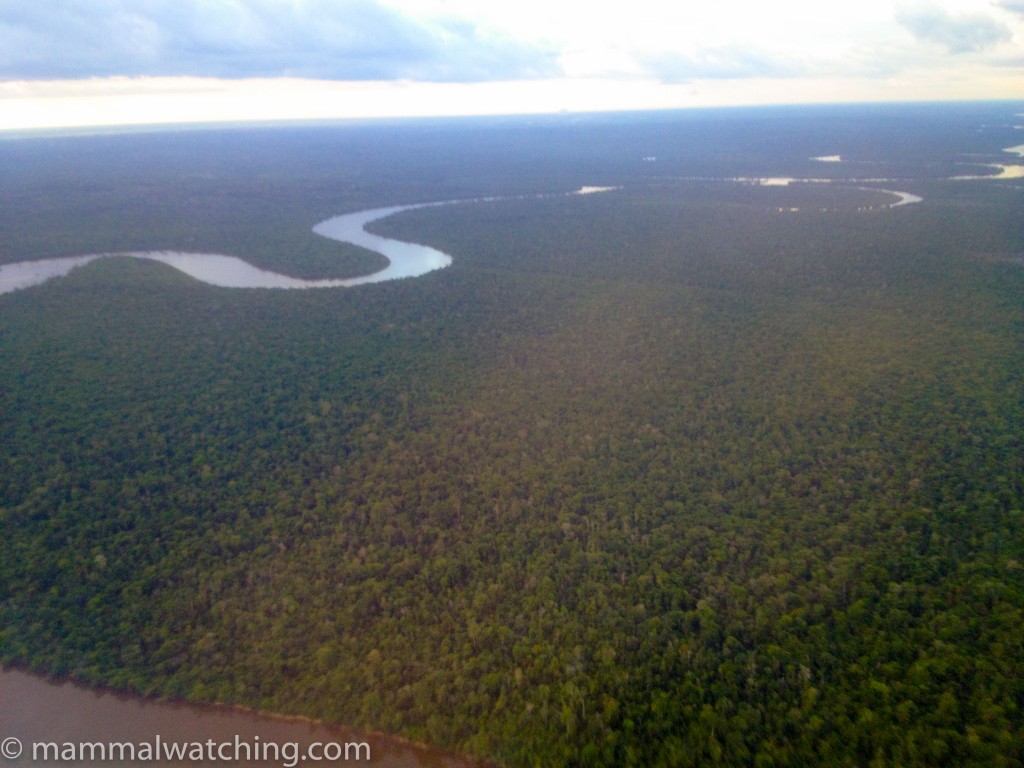
Approaching for landing into Iquitos
We were met at the airport and bundled into a mototaxi (Peruvian for tuktuk or autorickshaw) for the 20 minute drive to the Greentrack hostel downtown that Katoo also runs. A night in the hostel is part of the package. It is fine, but if you want more luxury or hot water, particularly when returning to Iquitos after the jungle, you might want to stay in a hotel.
It took all of the next day – 12 hours – to reach Tapiche Reserve. First, we had to take a mototaxi to the bus station, then a minibus for an hour to the port of Nauta, then another mototaxi to the river itself (go figure … this is almost as bad as the taxi protection racket at Newark Airport). From there it was three hours by fast, cramped, commercial speedboat to the last town on the river: Requena (generally most tours travel all the way from Nauta with Katoo’s own boat which is more comfortable). When sharing a double seat on any form of public transport the Peruvian etiquette is simple and straight from an army playbook. Occupy as much territory as possible and fight to preserve it.
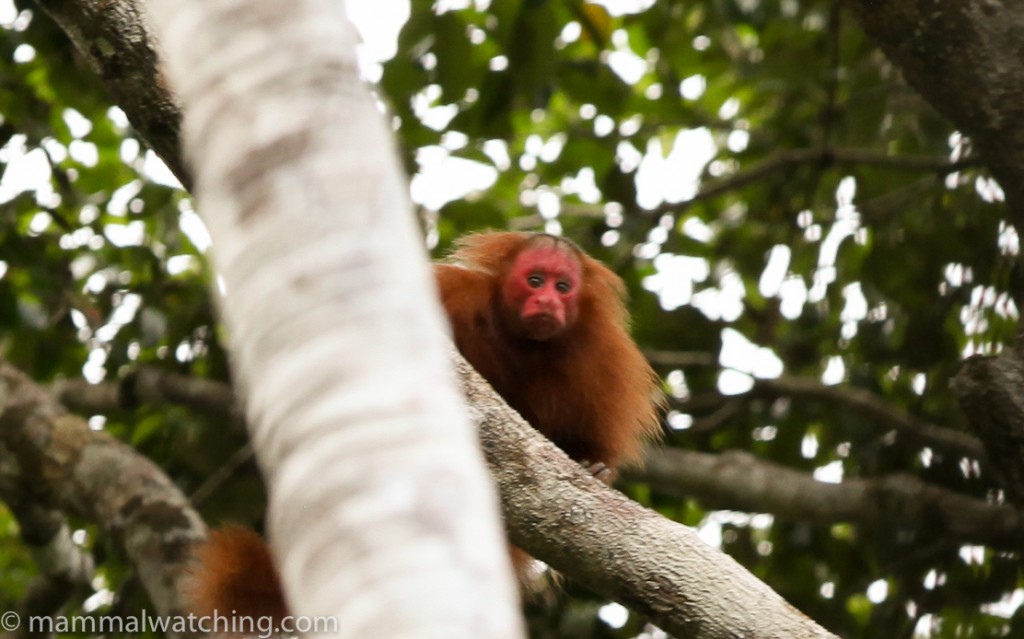
Red Uakari, Cacajao calvus
After lunch the five in our group transferred into the lodge’s boats and we spent five hours in relative luxury (compared to the public ferry) travelling up increasingly quiet rivers.
Tapiche’s location, Lat -5.639882, Lon -73.984895, is here.
We slowed down to enjoy the sights and I was particularly impressed by how common river dolphins were. Every couple of minutes we would see small pods of Botos or Tucuxis surfacing. Another highlight was spotting an endangered Amazon Yellow-spotted River Turtle on the bank laying eggs. Eggs which were almost certain to fall victim to local poachers or the Iguanas watching from the bushes, so Katoo collected the clutch to hatch them in the lodge and then release the young.
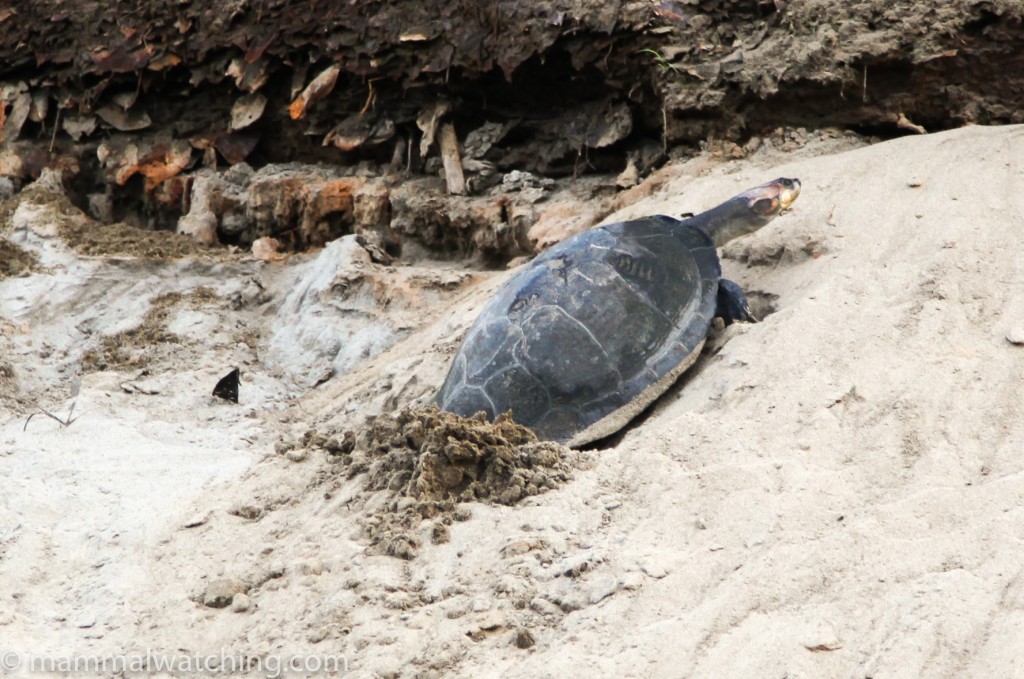
Yellow-spotted River Turtle
The lodge was just as I’d hoped. Three small wooden cabins with mosquito net walls, plus a kitchen/dining room. The showers came straight from the river and there was electricity only for a couple of hours each night when the generator came on. Perfect.
DAY 1
We were up at 5 a.m. each day. Patrick and I had opted for a private tour, so we could have a guide to ourselves, and on the first morning Jose Jr., one of the local Matse Indians, took us to look for Uakaris. The first mammals of the day were a few Capybaras, 20 minutes upriver from the lodge. In the forest Jose demonstrated his excellence at spotting stuff and during our first morning we saw an impressive six species of primates.
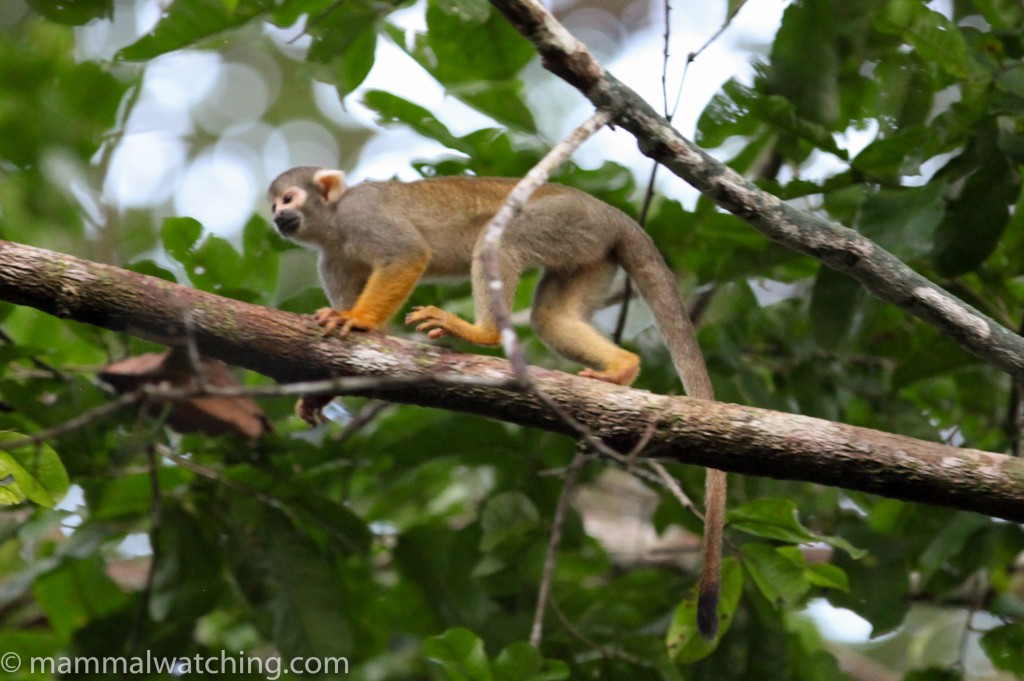
Bolivian Squirrel Monkey, Saimiri boliviensis
The walk began with the first of many Bolivian Squirrel Monkeys (a lifer for me), travelling with a few Brown (Large-headed) Capuchins, shortly followed by a brief look at a single Juara Red Howler and a few Illiger’s Saddleback Tamarins.
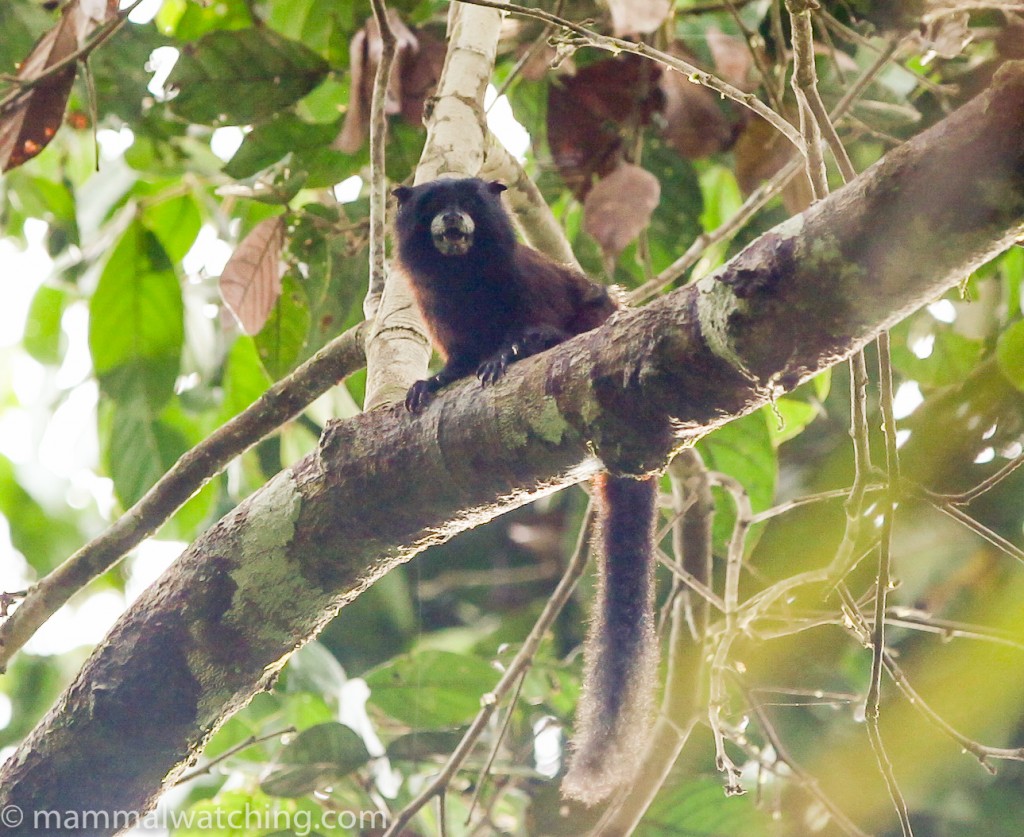
Illiger’s Saddleback Tamarin, Leontocebus illigeri
At about 10 a.m. we heard some large primates crashing through the trees which we soon realised was a big troop of Peruvian Red Bald-headed Uakaris. Seriously strange: Patrick described them as “Russian Mafia Monkeys” , with their big fur coats and beaky heads. Almost as good as the Portugese name for this species “The English Monkey”: their bald red heads reminded them of suburnt English explorers.
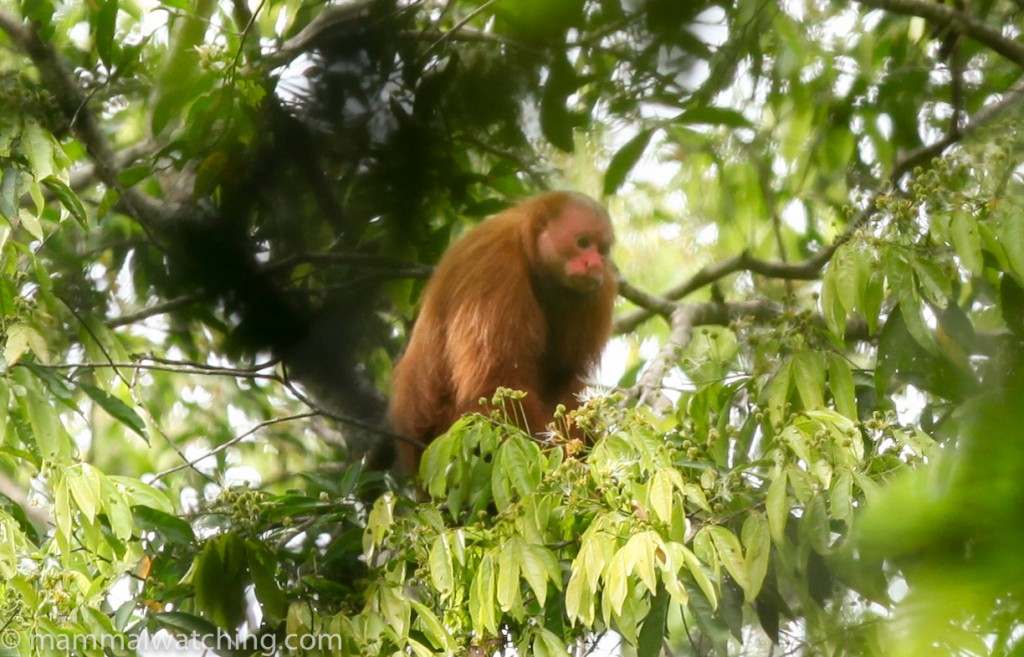
Peruvian Red Bald-headed Uakari Cacajao ucayalii
We were with them for 20 minutes and had great views, though they were extremely mobile and difficult to photograph through the trees. The troop, it seems, are nearly always in the same area. And as Jacob Socolar had advised, they can reliably found almost every day at Tapiche, which seems not to be the case elsewhere in Peru.
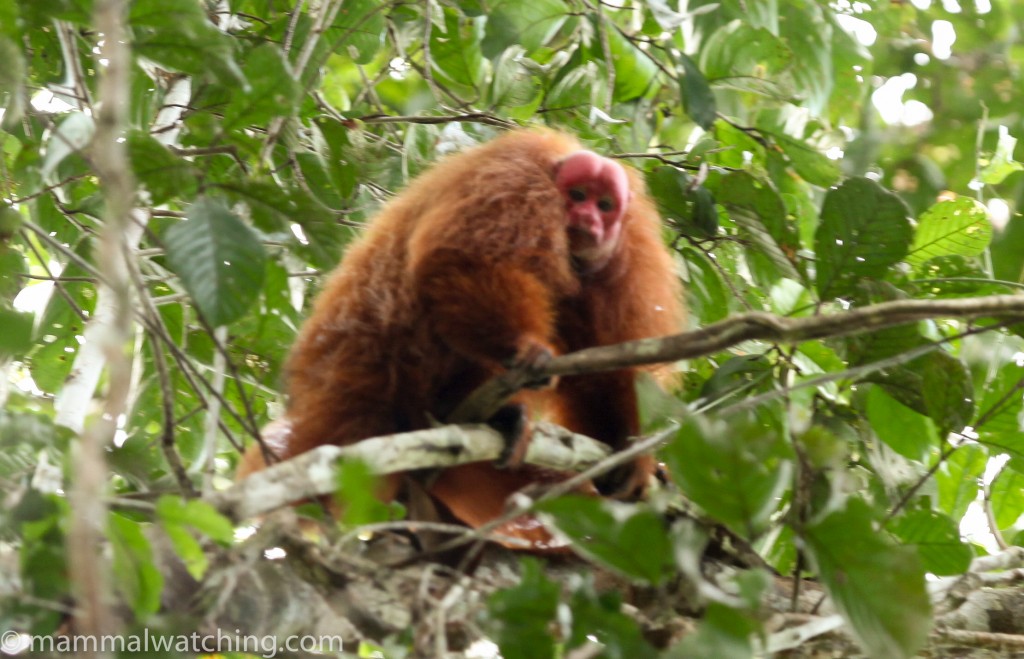
Peruvian Red Bald-headed Uakari Cacajao ucayalii
On the way back to the boat we heard a knocking sound which Jose correctly identified as a monkey trying to crack open a very large nut. Sure enough, after 10 minutes’ search Patrick spotted a Marañó White-fronted Capuchin, one of the less often seen monkeys. Nearly back at the boat, a little after midday, we saw a couple more Uakaris.
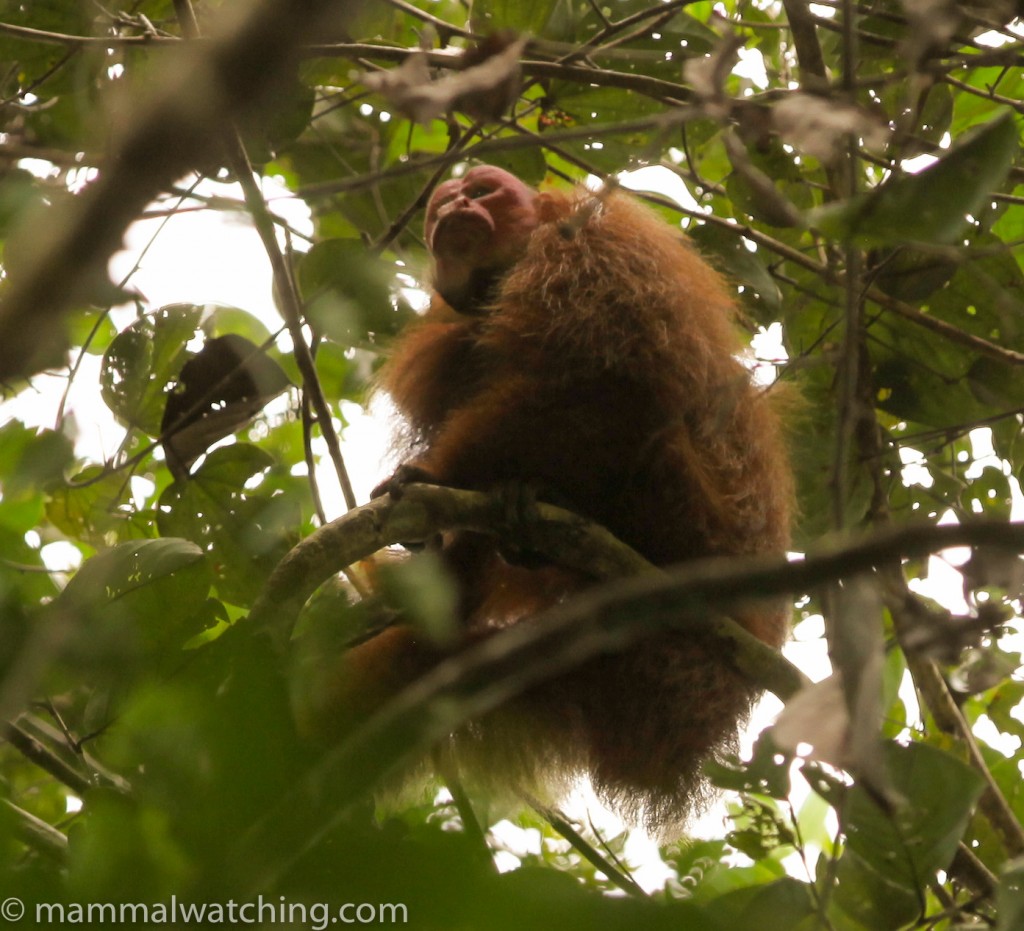
Peruvian Red Bald-headed Uakari Cacajao ucayalii
The only other mammals that morning were half a dozen Amazon Red Squirrels, including a black morph. According to my field guide it is virtually impossible to pick Northern from Southern Red Squirrels unless they are in the hand. However at least some of these animals had blackish feet so I am pretty sure (if my field guide is to be believed) that they were Southern Amazon Red Squirrels.
We spent the afternoon on the river and along a black water creek trying to photograph both species of river dolphins. The dolphins were everywhere but getting a decent photo during their brief surfacing was all but impossible.
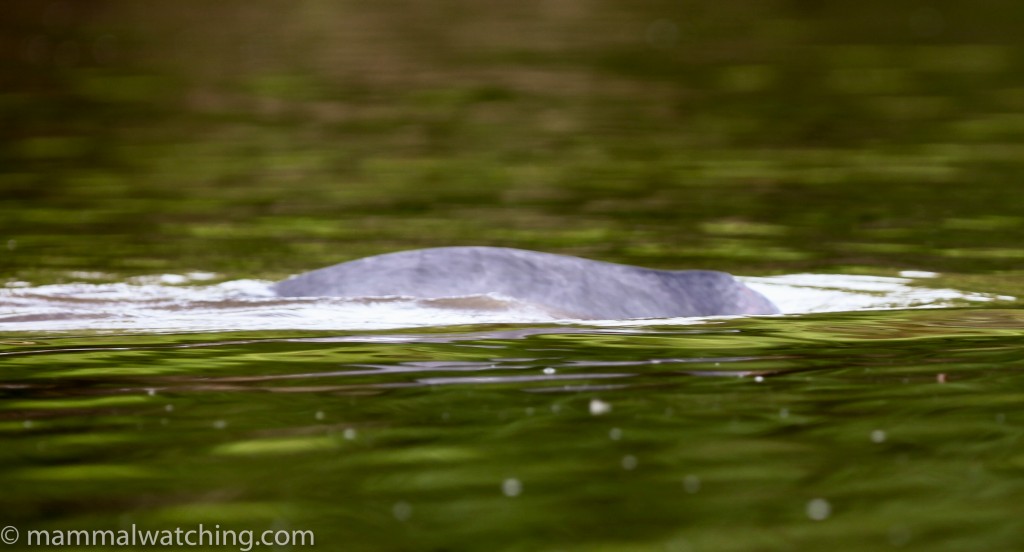
Back of a Boto, Inia geoffrensis
On the way back to camp Jose spotted a Brown-throated Three-toed Sloth hanging from a bare branch. Southern Two-toed Sloths ought also to be in the area but Katoo had never seen one.
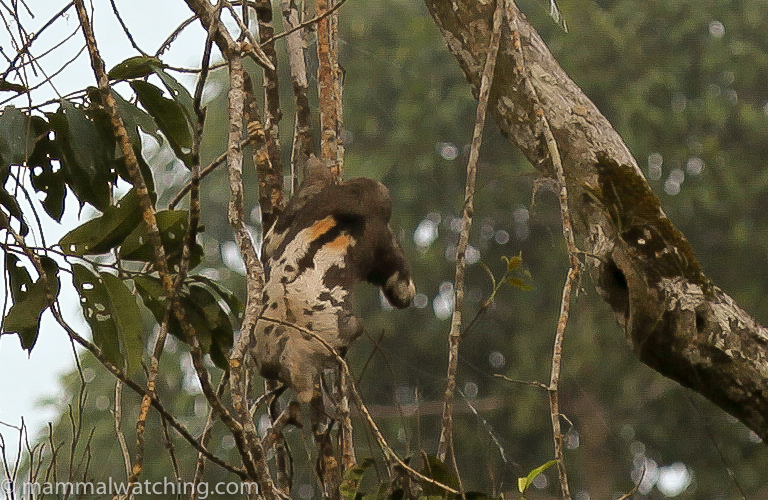
Brown-throated Three-toed Sloth, Bradypus variegatus
I took a short spotlight walk with Jose that evening behind the lodge. The trail, through thick secondary forest, was pretty useless for spotlighting and we didn’t see any mammals. Spotlighting from a canoe along a creek ought to be much more productive but is only possible when water levels are higher.
Day 2
The night had been eventful for Katoo. As I was drifting off to sleep I heard a gunshot and then a outboard start up. Over breakfast (tasty porridge as always) Katoo explained he’d heard the shot close by and gone down to the river to investigate, only to see hunters had killed a Caiman directly opposite the lodge. Katoo jumped in his boat to confront them and their gun jammed when they tried to get a shot off, presumably in his direction. Katoo, unarmed as always, confiscated both the gun and the Caiman and told them to get the hell out of town. As Patrick said, “Katoo is the toughest person I’ve ever met”. I’m inclined to agree, though Patrick’s sister comes a close second if you come between her and a plate of bacon.
Katoo had other similar stories about his waging a one man war against poaching on his property. Unlike the poachers through Katoo refuses to carry a weapon even though he cannot rely on ineffective local police who, he said, will do nothing to prosecute the perpetrators and need a “tip” just to come to investigate. A familiar story but a sad one. The only consolation was Caiman for dinner that night to accompany the omnipresent – though very good – spaghetti.
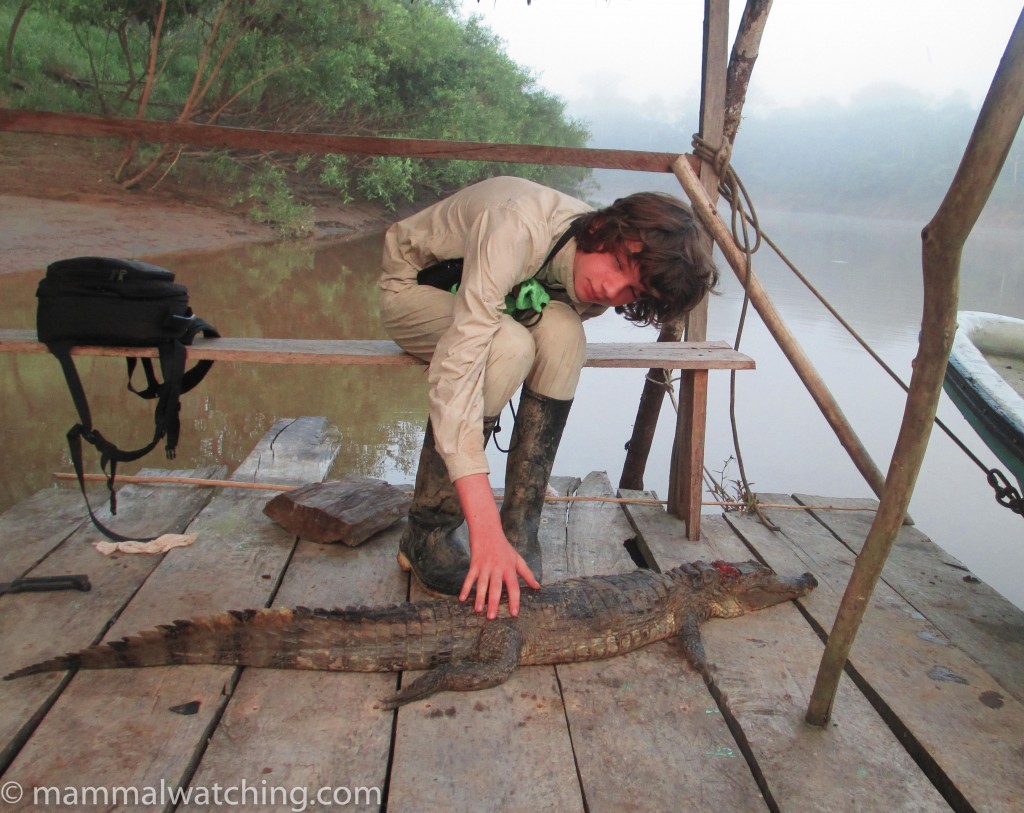
Patrick and the Caiman: poached then fried.
Katoo had told me about Garza Lagoon on the reserve – which at 3.5km long is the second largest lagoon in Loreto – in which he’d seen Amazonian Manatees a few times. This animal is near mythical: in all the conversations I’ve had in the Amazon I’ve heard only rumours of places in Ecuador and Colombia where you have a chance of seeing one during a six week stay but I’d never come across better odds that that. Naturally I was keen to visit.
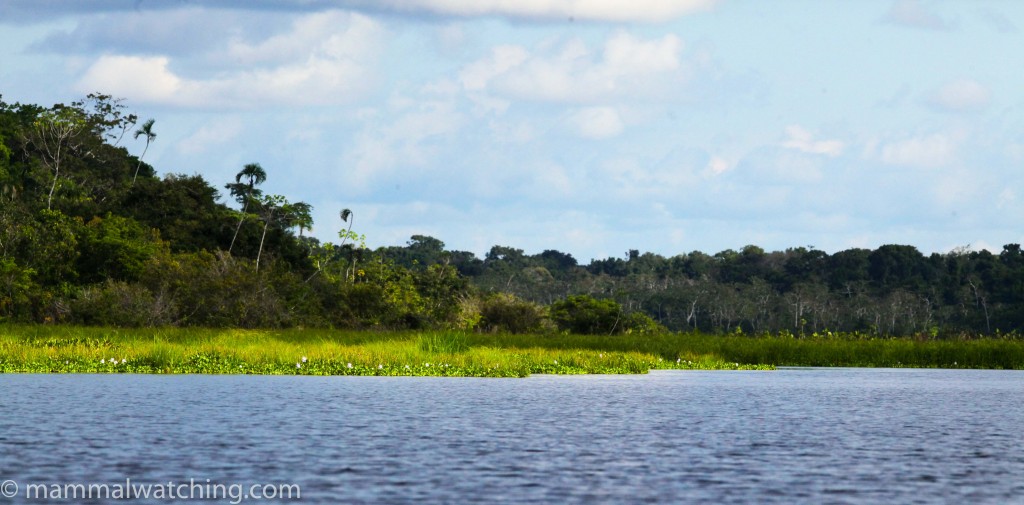
Garza Lagoon
Access by boat wasn’t easy and there was no boat in the lagoon already. But Katoo had a plan: he, Patrick and I would trek there, while a couple of guides and another two visitors would motor, push and carry, a canoe along a creek and meet us at the lagoon. Our walk took about three hours through some really lovely primary gallery forest with a wide open understorey and immense trees. The area is home to Woolly Monkeys, though we didn’t hear any. In fact the only mammal of the walk was another Red Squirrel.
It took the canoe team a further two hours to get there. But by the early afternoon we were cruising up the lagoon. It is hard to imagine anywhere more perfect.
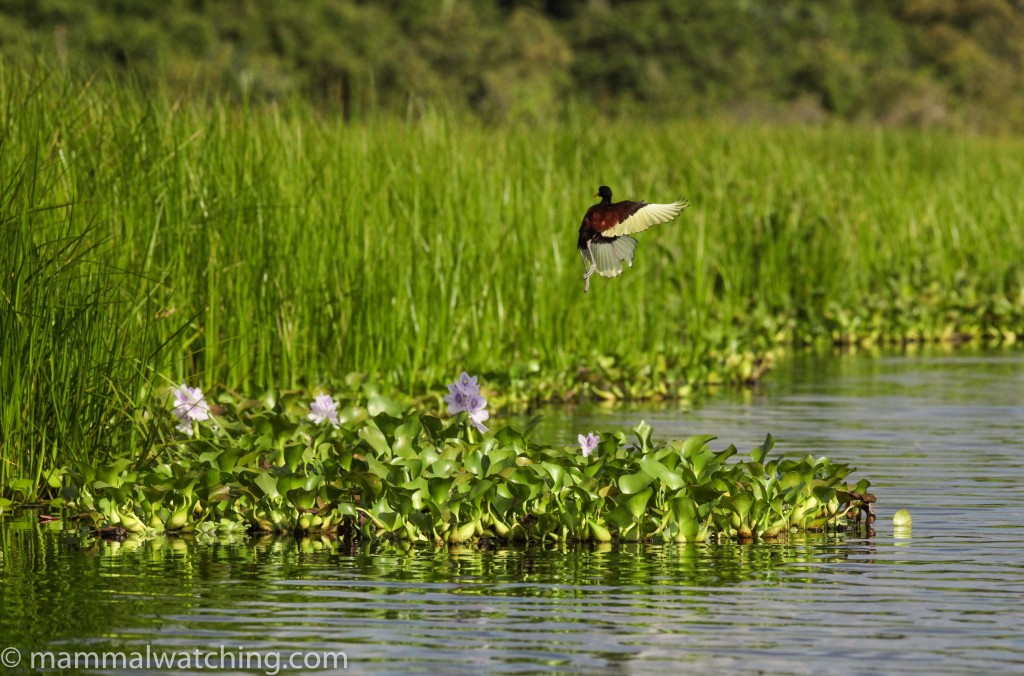
Garza Lagoon
At the very far corner of the lagoon, next to a thick bed of reeds and water lilies, I saw a grey head break the surface, and then a grey head and back rise up and disappear. Could it have been a Manatee? Jose, our Indian guide said it was. Katoo was 90% sure: he was certain it wasn’t a Boto which were also hanging out in the same area, but thought it might possibly have been a river turtle. I was pretty sure it was a manatee too but it was only the next day, when the other group of guests at the lodge visited and saw an Amazonian Manatee in precisely the same place that I was fully satisfied I’d seen one. An unexpected species and the mammal of the trip for me.
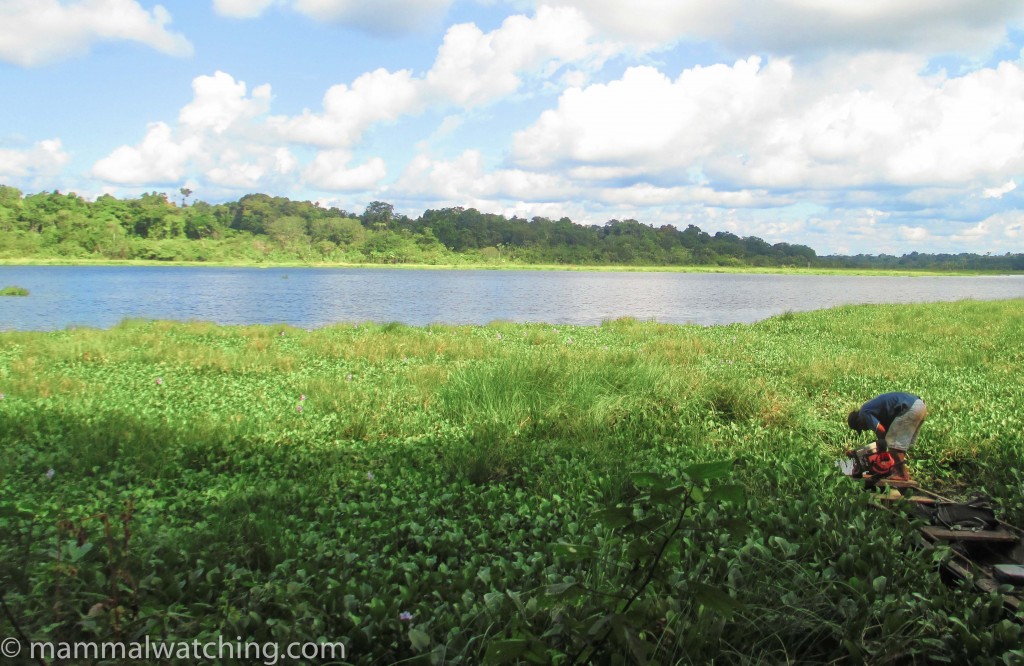
Manatee habitat (photo Patrick Hall)
Riding the boat back we spotted a bird eating spider swimming across the lagoon which we rescued on a machete and deposited back in the lillies.
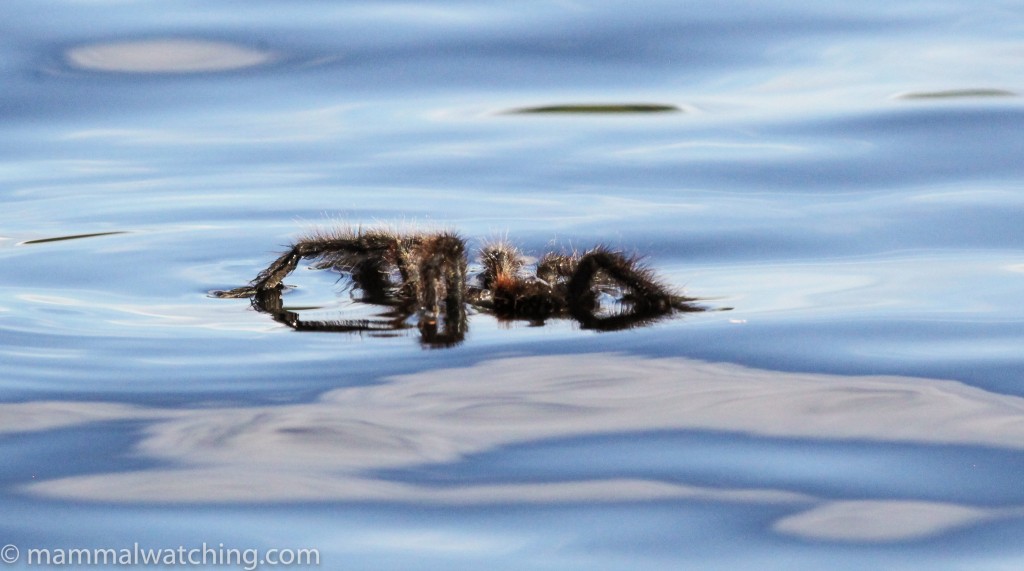
Bird-eating Spider, swimming
We walked back to the river quickly in a large group so it wasn’t all that surprising that we didn’t see any mammals other than a troop of squirrel monkeys.
I was too tired to do much that night, but I had left a couple of traps in the kitchen to try to catch the climbing mouse that was nesting in the beams. I was pleasantly surprised to catch it using a few scraps of spaghetti as bait given the wealth of available food in the kitchen bin. Fiona Reid identified it as a Bi-Coloured Rice Rat, a common arboreal mouse of Amazon camps.
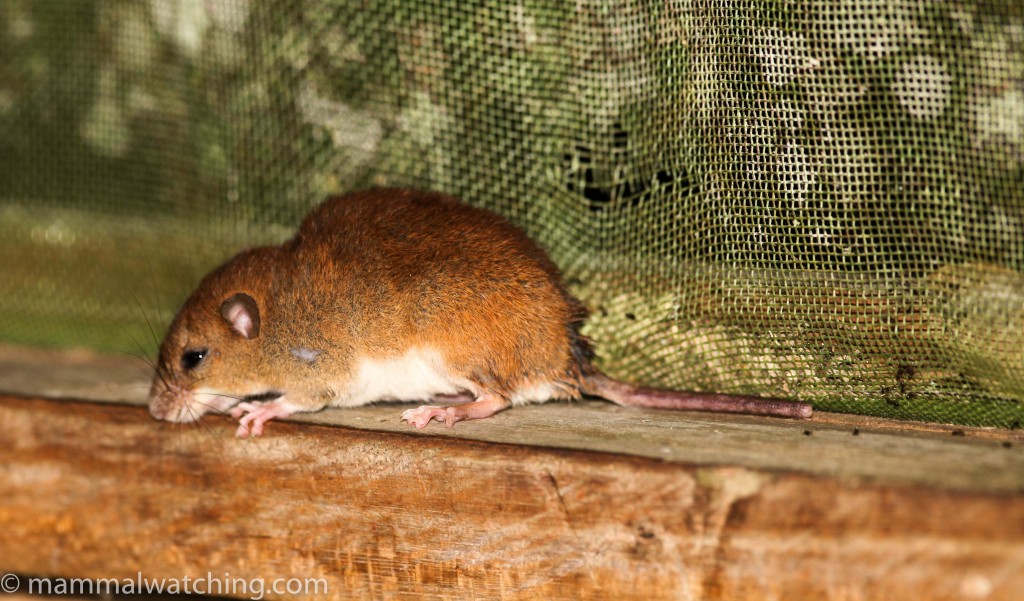
Bi-coloured Rice Rat, Oecomys bicolor
Walking to and from my cabin I twice spotted a very large rat that might have been an Armoured Rat, though I only saw enough to be sure of its size rathern than its identity.
Day 3
On our last day in the reserve we took a morning walk in the same area we’d visited on our first morning to look for Saki, Spider and Woolly Monkeys. A couple of peccaries ran across the trail as we started – probably Collared Peccaries – and a nice sighting for Katoo who hasn’t seen many in the reserve before. After spotting more Red Squirrels, we saw a troop of Squirrel Monkeys and then a few Saddleback Tamarins.
Sure enough we found the Uakaris close to where we’d seen them on our first day, and 30 minutes later a large troop of Squirrel Monkeys came through accompanied by Brown Capuchins and at least one Woolly Monkey, which frustratingly I couldn’t get onto. The troop passed close to some Red Howler Monkeys, and Katoo spotted one of them, though I was too busy looking for the Woolly Monkeys to turn my bins in the howler’s direction.
In the late afternoon Katoo and I took a walk in the forest behind the lodge. The only mammals were a troop of Coatis (hitherto uncommon in the reserve) and what sounded like some largish primates crashing through the trees that may well have been howlers.
I put up a net briefly in the evening a caught a small bat that Fiona Reid helped me to identify as an Andersen’s Fruit-eating Bat, another lifer for me.
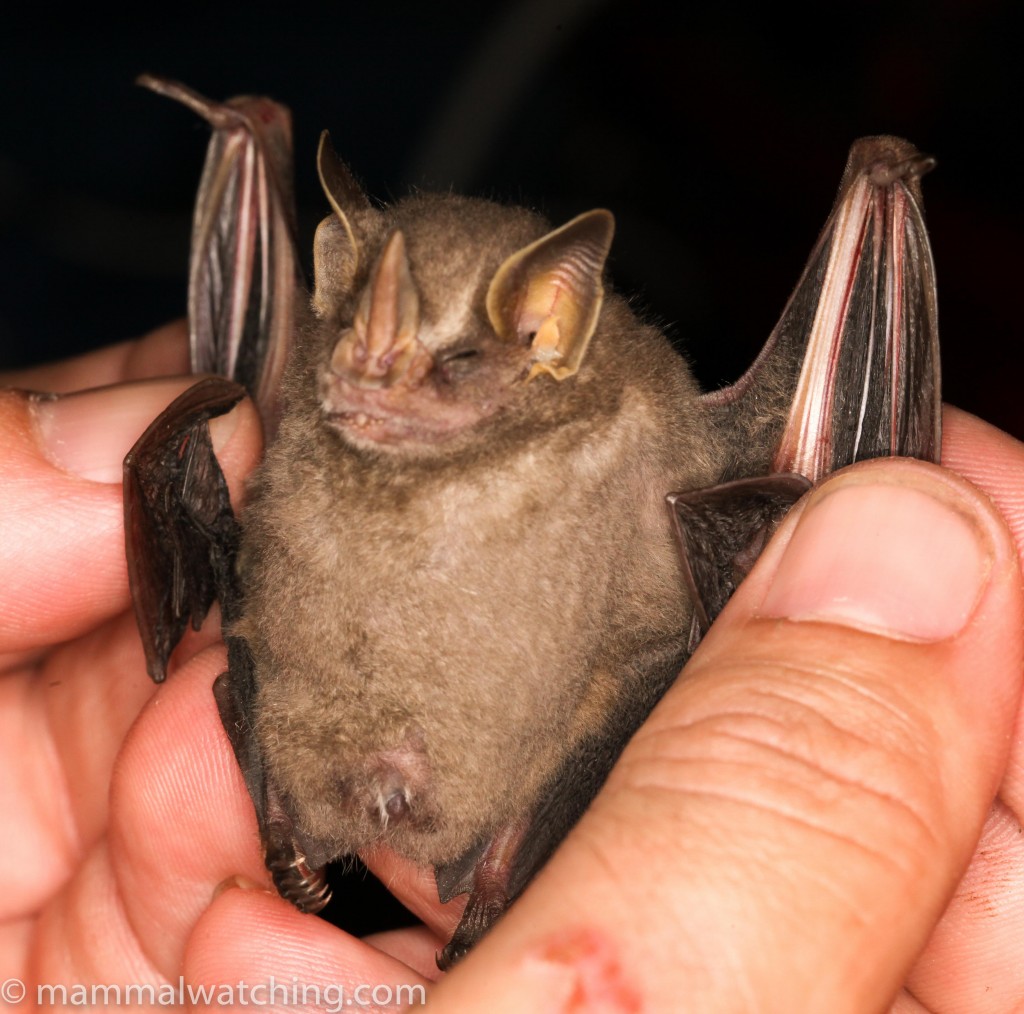
Andersen’s Fruit-eating Bat, Artibeus anderseni
We left camp, not ready to leave Tapiche, at 6 a.m. next morning and after some hard core boating, we were at Iquitos airport 11 hours later in time for our flight back to the USA. My advice – for the sake of your blood pressure – would be, unlike me, to schedule a flight for the day after you leave Tapiche rather than the same evening. It is a long way back to Iquitos and there is considerable scope for delay.
Closing Thoughts
Tapiche is the perfect place for a serious wildlife enthusiast to explore the Amazon. Katoo is a legend, and his guides are excellent at finding animals. And those animals are there in good numbers. Uakaris and Manatees are alone enough to justify the trip in my opinion. But add to that the great range of primates, and the freedom to look for creatures great and small away from the groups of tourists that are more common in Amazon lodges mean this must be one of the better places to experience the Amazon. I wish we’d had more time and I hope to get back.
Katoo also seems an impressive force for good. He clearly has a deep concern for wildlife and the livelihoods of the local people and is putting all of his energy into building a viable business that can better protect this slab of forest. Just a year into the project and animals are returning in numbers so wildlife spotting is going only to improve in my opinion. Tapiche is a testament to what one person can achieve so I’m hoping to read more trip reports from others over the coming months and years.
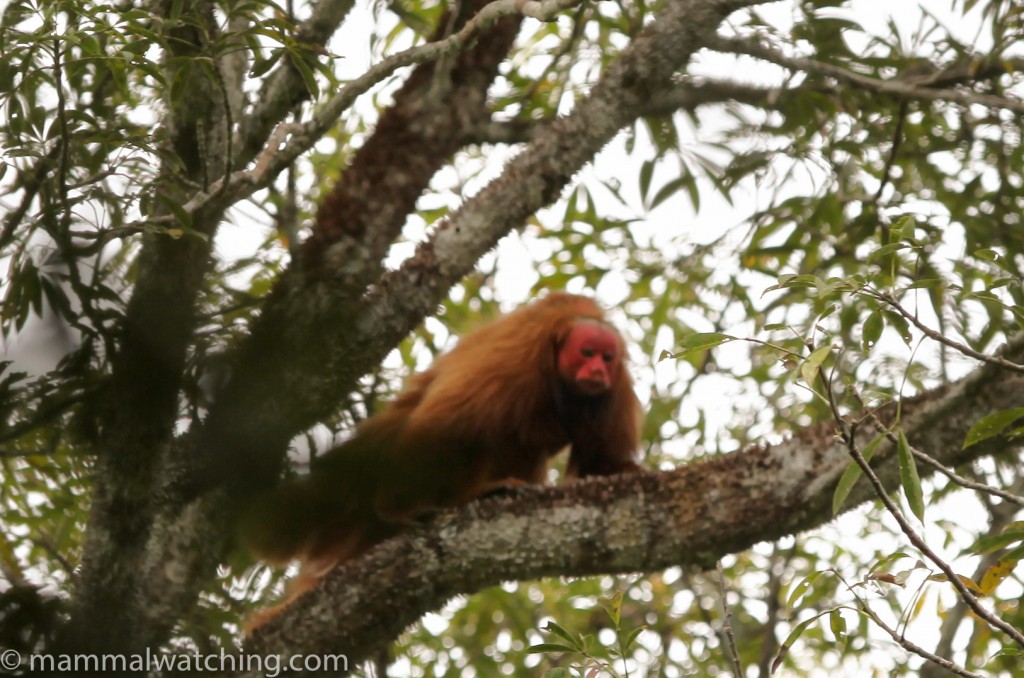
Peruvian Red Bald-headed Uakari Cacajao ucayalii
Stuff I Missed and Just Missed
I “just” missed a few animals while I was there. On our first morning Katoo was out with the other guests and saw both a Tayra (not uncommon) and some Black Spider Monkeys which are a rare sighting on the reserve though they can be, Katoo told me, reliably tracked down during the wet season near an Indian village an hour from the park (but access to that area needs a longish walk in the dry season and we didn’t have the time).
One night Jose Jr woke me because a couple of opossums were fighting near the kitchen. He identified them as Common Opossums but by the time I got there they had moved deeper in the forest where I could only hear them. Katoo also spotted a Water Opossum – for the first time – on the beach late one evening. His staff said they are not uncommon. Most frustrating for me was missing a Woolly Monkey on our last morning that was travelling with a large group of Squirrel Monkeys and Brown Capuchins. Both Katoo and Patrick saw it, but not me. It is a species I have only see once before and not well.
Other species that are reasonably findable on the reserve, that we didn’t see during our stay, included Kinkajous and Tamanduas (both more easily seen in the wet season during spotlighting boat trips along creeks), Giant Otters, two species of Sakis (Monk and Equatorial I believe), Noisy Night Monkeys and at least one species of large tree rat: Deborah from Tapiche has photographed the impressive Yellow-crowned Brush-tailed Rat in the reserve for instance, along the creek that leads to Garza Lagoon. One of the Mouse Opossums was also often seen in the kitchen. With a few more days I am pretty confident we’d have seen all the primates at least. We also saw Jaguar and Tapir tracks.
Many thanks to Jacob Socolar for first alerting me to Tapiche’s existence and to Katoo for being so flexible when I was setting the trip up and, along with his great staff, for looking after us so well when we were there.
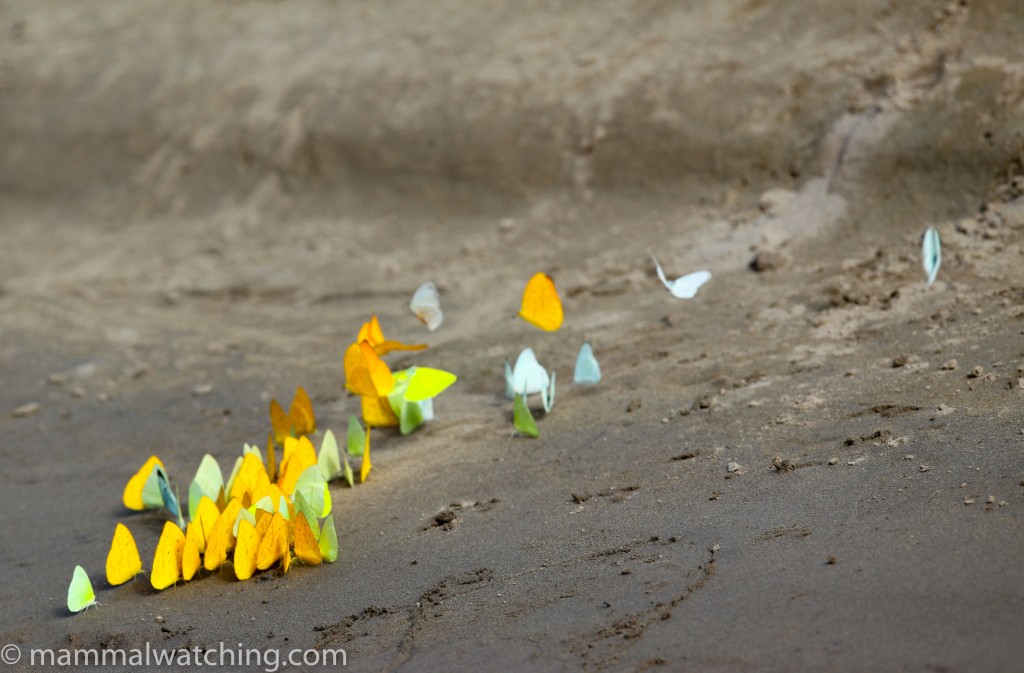
Trip List
Brown-throated Three-toed Sloth Bradypus variegatus
Guayaquil Squirrel Sciurus stramineus
Southern Amazon Red Squirrel Sciurus spadiceus
Bicolored Arboreal Rice Rat Oecomys bicolor
Peruvian Cotton Rat Sigmodon peruanus
Capybara Hydrochoerus hydrochaeris
Armored Rat Hoplomys gymnurus (uncertain)
Sechuran Fox Pseudalopex sechurae
South American Coati Nasua nasua
Andersen’s Fruit-eating Bat Artibeus anderseni
Illiger’s Saddle-backed Tamarin Leontocebus illigeri
Bolivian Squirrel Monkey Saimiri boliviensis
Marañó White-fronted Capuchin Cebus yuracus
Large-headed Capuchin Cebus apella
Peruvian Red Bald-headed Uakari Cacajao ucayalii
Juruá Red Howler Alouatta juara
Amazon River Dolphin (Boto) Inia geoffrensis
Tucuxi Sotalia fluviatilis
Collared Peccary (Javelina) Dicotyles tajacu
White-tailed Deer Odocoileus virginianus
Amazonian Manatee Trichechus inunguis
21 species, 10 lifers (in bold)


Leave a Reply
You must be logged in to post a comment.